How to make backup lighting in the house?
Lamps on batteries
Now electronic components have made a breakthrough in development and miniaturization. Economical LED diodes in power can become the main source of lighting. Batteries have become affordable, and sophisticated devices fit in the chassis of a single chip. The industry now produces emergency self-contained luminaires of compact sizes, installed permanently or with the possibility of mobile movement.
The scheme of operation of the devices is quite simple. In the normal state, when there is voltage at the input, the electronic circuit charges the battery and monitors its condition. At the time of a power outage, the lamp starts from the battery, and emergency lighting is turned on.
You can make a stand-alone stand-alone light source from the trash. Previously, fluorescent lamps were used for luminaires, however, such schemes are relatively complex for independent repetition, due to the presence of a high-voltage converter. With the advent of LEDs, it has become much easier, since it can also be powered from a source of 3 volts. On the Internet, there are many radio electronic circuits collected by radio amateurs or copied from serial, ready-made samples. Let's analyze the simplest backup lighting scheme for a residential building:
The source of 12 volts can be any network adapter designed for this voltage. Diodes VD1 and VD2 block the discharge current through the components of the device. Resistor R1 limits the charging current of the battery. The power switch, in the presence of a voltage of 12 volts, is closed by a positive potential at the base of the transistor. The toggle switch S1 is forced to open the key. Removing the positive bias from the base with resistor R2, opening the transistor and connecting the battery to the light source. This scheme can be repeated independently, the choice of elements is not critical, and can be redone to a different voltage. There is where to roam.
The second emergency lighting scheme of the house is more complex, it contains a chain of charge control, batteries:
The integral stabilizer LM 317 provides a constant voltage circuit, the T1 transistor is in the feedback chain, controls the amount of charge on the battery and regulates the stabilizer by adding or decreasing the voltage. On the T2 key, an emergency lighting start-up circuit is organized. If there is a positive voltage at the base, the LEDs do not work.
In the described devices there is one caveat, they monitor only the presence of voltage at the input.If during daylight hours there is an interruption in the supply of electricity, emergency lights honestly work out their purpose. Those. They will work until the battery is exhausted or power is supplied. Therefore, it is better to make backup lighting according to the following scheme:
In this embodiment, there is a photo relay that will not allow you to turn on emergency lighting in the house during daylight hours. On the transistor T1, an illumination control unit with a LDR1 photoresistor is organized. As you can see, they are not complex, the elements are accessible and common.
Ups
As a turnkey solution, you can use computer uninterruptible power supplies UPS. The laying of the emergency lighting group in this case should be carried out by a separate cable, from the power group, but to supply the luminaires in transit through UPS.In this device, you can use conventional and fluorescent compact lamps with 220 volts.
By the way, about how to choose an uninterruptible power supply, we told in the corresponding article. Check out the tips if you want to make emergency lighting in your home using a UPS.
An overview of this idea is provided in the video:
Another interesting idea is depicted in the diagram:
This circuit has a charger, a low voltage relay, a diode, and a 12/220 converter. You can not put it, but instead use 12-volt LED modules.
In the normal state, when voltage is supplied to the charger, the relay connected to the terminals is retracted and the modules are not connected to the battery. When the supply to the charger stops supplying voltage, the relay closes another group of contacts, including light modules. The diode in the circuit blocks the discharge of the battery through the relay coil. This project, you can’t imagine easier, therefore it will be within the power of a person who is far from the nuances of electronics.
Battery-powered LED lamps
On the expanses of online stores there are lamps that look like ordinary LEDs, but they have a battery that allows you to work for some time in the absence of electricity. This unit has a standard E27 base and fits in most luminaires in size.
Using the switch, you can select the lamp operating mode, as a cumulative - emergency, or normal mode. Using LED bulbs on batteries, you can make backup lighting in an apartment or apartment building without any effort. The disadvantage of rechargeable LED lamps is high cost, about 500, however, given that for all rooms costs will be about 3 thousand, we can say that it is not so expensive.
Finally, we recommend that you look at another idea of organizing backup lighting in a private house or a garage based on solar panels:
About, how to connect do-it-yourself solar panels, we also talked in a separate article!
Rules and requirements
Regarding emergency lighting in the premises, there are several rules for PUE and other equally important regulatory documents. So, if you decide to make backup light sources in a private house or in a country house, consider the following requirements:
- In any room there must be at least two emergency lights, in case one comes into disrepair.
- The luminaires should be spaced apart to ensure a minimum illumination in 1 Lx, in the center of the corridor, on the escape route.
- Emergency lighting devices should not be further than two meters from important points of the object (walkways, doors, turns, stairs, control panels).
- A lamp must be installed at each door to exit the room, as well as on the landing, in the corridor, pantry and even toilet. However, for home conditions, this rule is not so important, here you can be guided only by your preferences.
That's all I wanted to tell you about how to make emergency lighting in the house with your own hands.We hope you enjoyed our ideas!
We also recommend that you read:

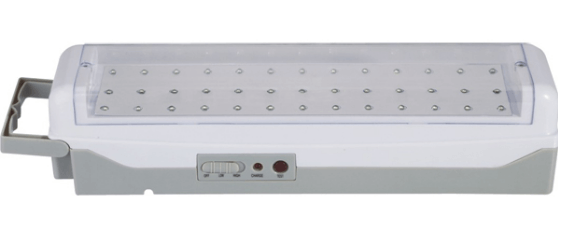
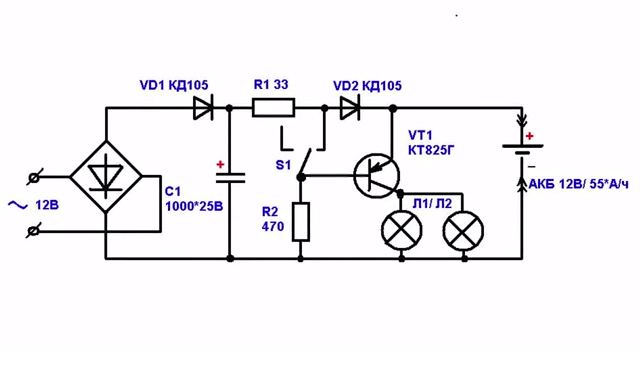
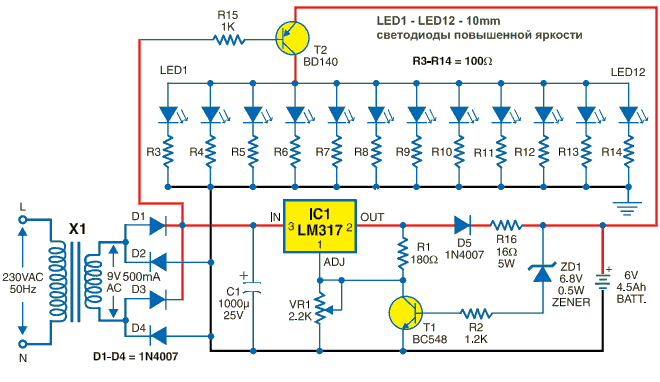
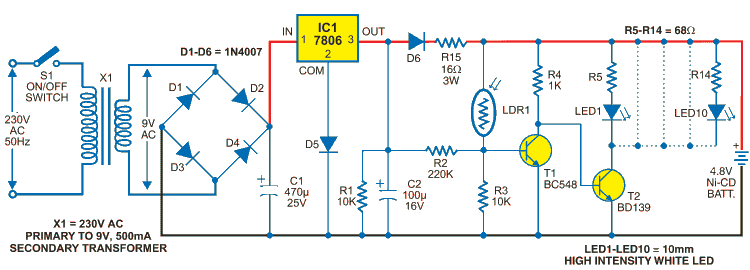
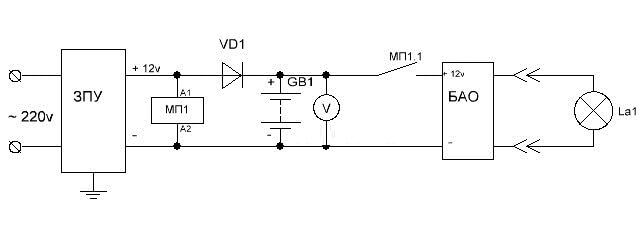
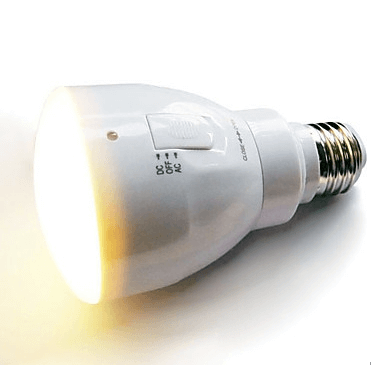


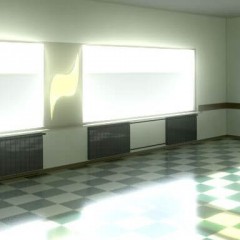
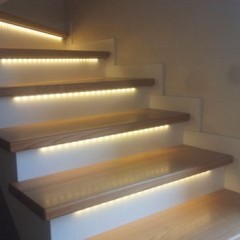
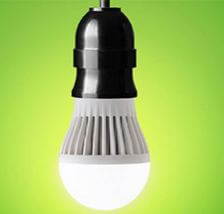

I am very sorry, but there is an error in the very first scheme. The diode bridge has a diode symbol upside down.
Sincerely, Sergey, electronic engineer, 43 years old.
Good afternoon. The following question arose: Is it possible to use LED lamps powered from a redundant power source, for example RIP-12 isp.06 (RIP-12-6 / 80M3-R) manufactured by NPO Bolid?
> Good afternoon. The following question arose: Is it possible to use LED lamps powered from a redundant power source, for example RIP-12 isp.06 (RIP-12-6 / 80M3-R) manufactured by NPO Bolid?
Why not? The load current of this PSU is 6A. A contactor with an NC contact coil in the 220V network, NC contacts of the contactor in the lamp circuit at the output of this power supply. If there is no voltage on the coil of the NC contactor, the contact closes, the light turns on. The batteries are not protected by the discharge protection, when the mains voltage appears, the contactor turns off the lamps, and the PSU charges the batteries.
Only this PSU can be redundant, in an average apartment it is possible to keep within 10-15 watts of lamps, emergency lighting does not require duplication of the main one, only to be able to move around especially in rooms without natural light, and the shield was lit.